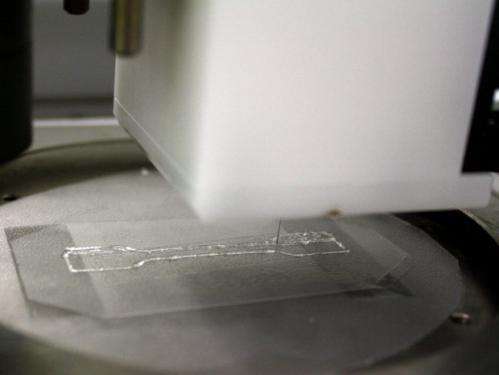Conductive gelatin can be 3-D printed... and eaten. Credit: University of Wollongong, via IEEE Spectrum
A team of researchers working at the University of Wollongong in Australia has received the go-ahead for a seven year study with the goal of looking at the possibility of using additive manufacturing techniques to develop biosensors made from edible gels. Team lead Marc in het Panhuis along with colleague Alex Keller recently gave a presentation to attendees at a Materials Research Society, Symposium, entitled "Printed Organic Electronic Device Components from Edible Materials." Their aim is to learn if it might be possible to use ordinary edible gels to create biosensors that when consumed, could provide physicians with data regarding the internal state of a patient.
Traditionally, objects printed with 3D printers are hard—in het Panhuis and his team want to take the technology further, into the 4D realm, which is where objects that are printed change shape after the printing is complete. They believe that combining gels that are already eaten by people, such as those made using gelatin or other foods that jiggle, such as puddings, could lead to the creation of gels that could serve as a biosensor.
The first hurdle, he explained, is to make the finished product harder—the jiggly stuff is too fragile. That can be done by mixing a gelatin with genipin (from the gardenia plant, normally used to treat inflammation) and gellan gum (normally used to thicken pastries). Next, they'll soak the hydrogel in saltwater for several days allowing for crosslinking, which will also make the gel more stable. Gels are of course mostly water, which is highly conductive, as of course is salt. Combined, the two can provide the basis for a very good biosensor. The team envisions, printing bite-sized sensors using a 3D printer (the gel would be heated inside to make it liquid), which as they cool down would take the form of the desired sensor. The main challenge at this point, he noted, lies with finding a way to read data from such a sensor in a reasonably easy way. He believes seven years should offer ample time to find a solution.
The team believes that their efforts will likely result in the development of other products for other uses as well, such as with soft robotics and other 4D printing applications.
More information: Printed Organic Electronic Device Components from Edible Materials, 2014 MRS Fall Meeting & Exhibit, November 30 - December 5, 2014, Boston, Massachusetts, www.mrs.org/fall-2014-program-a/
Additive fabrication techniques such as three-dimensional (3D) printing are receiving growing interest from a diverse range of fields due to their ability to quickly produce complex 3D objects. However, new applications of hydrogels such as soft robotics and cartilage tissue scaffolds require hydrogels with enhanced mechanical performance, which has stimulated an investigation into how hydrogels may be made electrically conducting, tougher and more enduring. Moreover, the parallel development of these materials and suitable 3D fabrication techniques has accelerated the advancement of many technologies including bionic implants, sensors, controlled release systems and soft robotics. The understanding of how to marry these recent advances in materials (e.g. tough and/or electrically conducting hydrogels) with manufacturing (3D printing of hydrogels) for the purpose of building smart hydrogel materials is incomplete. In this presentation I will describe our approach to 3D printing gels (consisting of the edible biopolymers gellan gum and gelatin) that is based on optimizing the rheological conditions for additive manufacturing with a 4th generation 3D-Bioplotter. Gellan gum and gelatin are versatile ingredients in well-known food products such as the commercially available product Aeroplane Jelly. The crucial aspect to facilitate printing is that these gels can be prepared in a "one-pot" synthesis approach. The resulting gels based on a combination of ionically cross-linked gellan gum and covalently cross-linked gelatin networks exhibit suitable mechanically (1 MPa tensile stress at failure) and electrical (1 S/cm electrical conductivity) characteristics. The origin of the mechanical robust and electrical behavior will be discussed in detail. In addition, I will demonstrate that the gel's mechanical and electrical characteristics vary with the concentration of the charge carriers. Finally, I will present our results on 3D printed (electronic) hydrogel devices for future application in bionics and soft robotics.
via IEEE Spectrum
© 2014 Tech Xplore
























